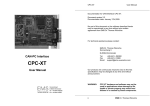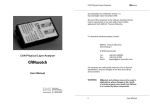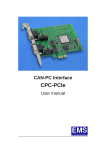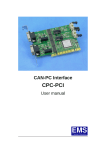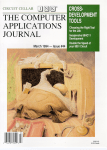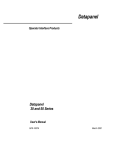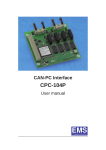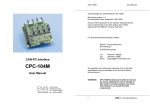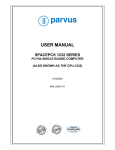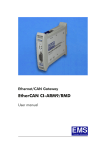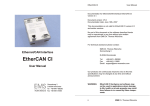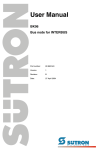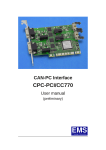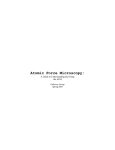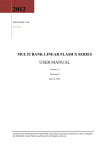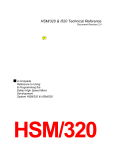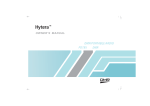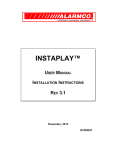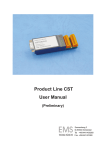Download Manual: CAN plugin card ISA/XT, active
Transcript
CPC-XTI User Manual Documentation for CAN-Interface CPC-XTI. Document version 1.3. Documentation date: January 17th, 2005. No part of this document or the software described herein may be reproduced in any form without prior written agreement from EMS Dr. Thomas Wünsche. For technical assistance please contact: EMS Dr. Thomas Wünsche Sonnenhang 3 D-85304 Ilmmünster CAN-PC Interface Tel. +49-8441- 490260 Fax +49-8441- 81860 Email: [email protected] CPC–XTI User Manual Our products are continuously improved. Due to this fact specifications may be changed at any time and without announcement. WARNING: EMS THOMAS WÜNSCHE Sonnenhang 3 D-85304 Ilmmünster Tel +49-8441-490260 Fax +49-8441-81860 ii CPC-XTI hardware and software may not be used in applications where damage to life, health or private property may result from failures in or caused by these components. EMS Dr. Thomas Wünsche User Manual CPC-XTI CPC-XTI User Manual THIS PAGE INTENTIONALLY LEFT BLANK Contents 1 Overview . . . . . . . . . . . . . . . . . . . . . . . . 1 1.1 1.2 1.3 1.4 Attributes . . . . . . General description . Sample Applications Ordering Information . . . . . . . . . . . . . . . . . . . . . . . . . . . . . . . . . . . . . . . . . . . . . . . . . . . . . . . . . . . . . . . . 1 1 2 3 2 Software . . . . . . . . . . . . . . . . . . . . . . . . 4 2.1 2.2 2.3 2.4 2.5 2.6 Functions of CPC-XTI . . . . . . . . . . . . . . . 4 Application program: Realization Concepts . . . . 4 Synchronous Interface . . . . . . . . . . . . . . . 5 Asynchronous Interface . . . . . . . . . . . . . . 5 Data Structures and Library Functions . . . . . . . 6 MS-Windows Driver Additional Information . . . . 15 3 Electrical Characteristics . . . . . . . . . . . . . . 17 3.1 Absolute Limiting Values . . . . . . . . . . . . . 17 3.2 Nominal Values . . . . . . . . . . . . . . . . . . 17 4 Operation Instructions . . . . . . . . . . . . . . . . 18 4.1 Connection Scheme. . . . . . . . . . . . . . . . 18 4.2 Configuration . . . . . . . . . . . . . . . . . . . 19 4.3 Installation . . . . . . . . . . . . . . . . . . . . . 21 EMS Dr. Thomas Wünsche iii iv EMS Dr. Thomas Wünsche User Manual 1 CPC-XTI CPC-XTI Overview application in 8 bit slots CPC-XTI can be used in space restricted conditions as well. Designed for industrial series applications CPC-XTI has a robust and cost efficient construction. 1.1 Attributes CPC-XTI offers a range of unique features which make it valuable for many CAN based applications: • • • • • • • • • • • • User Manual CAN-interface for industrial applications Available with one or two CAN-channels Compact size for 8-bit slots CiA DS-102 and IS0 11898 compatible physical layer Smart system with fast integrated microcontroller Dallas DS80C320 Equipped with CAN controller Philips PCA82C200 or SJA1000 Philips PCA82C251 CAN transceiver for increased robustness Extended ESD-protection of the CAN transceiver(s) Galvanic decoupling between PC and CAN bus Modular application interface with libraries for Borland C++, Borland Pascal and Microsoft C Optional MS-Windows driver with DLL based API and VxD technology for high communication throughput Automatic address range detection by memory managers. CPC-XTI eases the development of application software on the PC. The integrated microcontroller takes load of the PC-CPU and buffers and preprocesses CAN messages. A high level programming interface with modular design results in efficient software development. A library of interface routines for Borland C++, Borland Pascal and Microsoft C is included. CPC-XTI is shipped with one or two CAN channels. For high volume applications cost optimized versions without galvanic decoupling and with PROM based code storage are available. Interrupt channels 3 - 7 are supported. 1.3 Sample Applications The application area of CPC-XTI is wide. Some sample applications are detailed in the following and supported by corresponding software: • Online configuration of CAN networks • Network setup and analysis • Use of PCs as CAN nodes on the appli- 1.2 General description cation level CPC-XTI is a short PC plug-in board for the CAN bus. With its small size and the possible EMS Dr. Thomas Wünsche • Visualisation of process parameters in CAN based systems. 1 2 EMS Dr. Thomas Wünsche User Manual CPC-XTI 1.4 Ordering Information 10-04-201-20 10-04-211-20 CPC-XTI 2 User Manual Software The software consists of two parts. One part is executed by the microprocessor inside CPC-XTI. The application program runs on the PC and makes use of the interface library. CPC–104I/SJA1000S320-GTI CAN plug-in board with microcontroller Dallas 80C320 and 1 galvanically separated CAN channel with Philips SJA1000 2.1 Functions of CPC-XTI CPC–104I/SJA1000D320-GTI CAN plug-in board with microcontroller Dallas 80C320 and 2 galvanically separated CAN channels with Philips SJA1000 CPC-XTI offers enhanced functionality for CAN communication: • Transmission and reception of CAN-messages • Filtering and buffering of received messages • Measurement of bus-load The functions of CPC-XTI are accessed across the interface library of the PC. 2.2 Application program: Realization Concepts The library of interface functions supports two ways to implement the application program. The synchronous mode complies with conventional programming. The sequence of program steps is given by the program structure. Asynchronous mode allows event driven programming similar to the way used in graphical user interfaces. EMS Dr. Thomas Wünsche 3 4 EMS Dr. Thomas Wünsche User Manual CPC-XTI 2.3 Synchronous Interface main program command initiation wait for result command execution by CPC-XTI continue command initiation further program execution command execution by CPC-XTI use result EMS Dr. Thomas Wünsche User Manual 2.5 Data Structures and Library Functions Implementation of the main program with synchronous interface allows simple and clearly arranged programs with sequential control flow. It is suitable mainly for simple applications, which allow a predefinition of events to process. This is true if, for example, only CAN messages are to be received or only bus load measurement is to be realized. 2.5.1 Data Structures The following structures are declared in the include file CPC.H. Please notice that the structures and functions described in the following refer to the old DOS and Windows libraries and are included in this manual for compatibility reasons. The new structures and functions are described within the manual ‘CPC Series Development Kit for MS Windows Environment’. struct CPC_MSG 2.4 Asynchronous Interface main program CPC-XTI The asynchronous interface provides enhanced flexibility in reaction to events which are not predictable in their sequence of occurrence. Communication objects can be processed independent of program state, reactions can be configured flexible. For this purpose every communication object is handed on to a set of handling functions. Such functions are provided within the programming library. The application programmer can add routines as required by application purposes. 5 Declaration: struct CPC_MSG { unsigned char typ; unsigned char length; union { unsigned char genericmsg[]; unsigned char textmsg[]; char versionmsg[]; char serialmsg[]; struct CPC_CAN_MSG canmsg; unsigned char busloadmsg; unsigned char canstatemsg; struct CPC_CAN_PARAMS can_params_msg; }; }; Description: CPC_MSG serves for parameter transfer between application program and interface library. 6 EMS Dr. Thomas Wünsche User Manual CPC-XTI CPC-XTI User Manual struct CPC_CAN_MSG struct CPC_INIT_PARAMS Declaration: struct CPC_CAN_MSG{ unsigned short id; unsigned char length; unsigned char overrun; unsigned char msg[8]; }; Declaration: struct CPC_INIT_PARAMS{ struct CPC_CAN_PARAMS std_can_params; unsigned char secure_transmit; void interrupt (far * inthandler)(); }; Description: CPC_CAN_MSG serves for transfer of CAN messages between application program and interface library Description: The global variable CPC_Init_Params, which has this type, holds initialization parameters. struct CPC_CAN_PARAMS Declaration: struct CPC_CAN_PARAMS{ unsigned char acc_code; unsigned char acc_mask; unsigned char btr0, btr1; unsigned char outp_contr; }; Description: CPC_CAN_PARAMS defines initialization values for the CAN controller in CPC-XTI (type PCA82C200) EMS Dr. Thomas Wünsche 7 8 EMS Dr. Thomas Wünsche User Manual 2.5.2 CPC-XTI Synchronous Functions Syntax: #include cpc.h int CPC_CAN_Init(void); Description: CPC_CAN_Init() initialises the parameters of the CAN controller within CPC-XTI. The CAN-controller is set up with parameters supplied in the global structure CPC_Init_Params (declaration in cpc.h). These parameters can be changed before the call to CPC_CAN_Init(). CPC_CAN_Init is to be called before data transmission across the CAN is initiated. – CPC_Control Syntax: #include cpc.h int CPC_Control(int); Description: CPC_Control() serves for setup of the message types to be transmitted from CPC-XTI to the PC. The upper 6 bits select the type of message, the lower 2 bits determine the transmission behaviour. The properties that can be influenced are described in cpc.h. Return value: Syntax: #include cpc.h void CPC_Exit(void); Description: CPC_Exit() is to be called before leaving the application program. CPC_Exit() is in any case to be used paired with CPC_Init(). Return value: – CPC_Get_Busload Syntax: #include cpc.h int CPC_Get_Busload(void); Description: CPC_Get_Busload() measures the actual bus-load and returns it as percentage of the maximum bus load. Return value: Actual bus load: 0 corresponds to 0%, 255 corresponds to 100% bus-load. CPC_Get_Serial – EMS Dr. Thomas Wünsche User Manual CPC_Exit CPC_CAN_Init Return value: CPC-XTI Syntax: #include cpc.h char * CPC_Get_Serial(void); Description: CPC_Get_Serial returns the serial number of the connected CPC-XTI module. Return value: Pointer to a string with the serial number or NULL in case of errors. 9 10 EMS Dr. Thomas Wünsche User Manual CPC-XTI CPC-XTI User Manual CPC_Get_Version CPC_Read_Msg Syntax: #include cpc.h char * CPC_Get_Version(void); Syntax: #include cpc.h void CPC_Read_Msg (struct CPC_CAN_MSG *); Description: CPC_Get_Version returns the version number of the connected CPC-PP module. Description: CPC_Read_Msg() receives a message from the CAN. The received communication object is stored in a structure of type CPC_CAN_MSG, which is indicated by the pointer passed on function call. Return value: Pointer to a string with the version number or NULL in case of errors. CPC_Init Syntax: Description: Return value: Return value: #include cpc.h int CPC_Init(void); CPC_Send_Msg CPC_Init() initialises the communication with CPC-XTI. CPC-XTI is initialised to standard parameters, which are stored in the global structure CPC_Init_Params (declaration in cpc.h). These parameters can be changed on demand before calling CPC_Init(). CPC_Init() is to be called before using the other functions of the interface library. 0 –1 for correct initialization, for initialization errors. EMS Dr. Thomas Wünsche – Syntax: #include cpc.h int CPC_Send_Msg (struct CPC_CAN_MSG *); Description: CPC_Send_Msg() sends a message across the CAN. The function call passes a pointer to a structure of type CPC_CAN_MSG, which contains the communication object to be transmitted. Return value: 11 12 – EMS Dr. Thomas Wünsche User Manual CPC-XTI 2.5.3 CPC_Send_RTR Syntax: Description: CPC-XTI #include cpc.h int CPC_Send_RTR (struct CPC_CAN_MSG *); User Manual Functions for the Asynchronous Programming Interface CPC_Add_Handler CPC_Send_RTR() transmits a Remote-Transmission-Request message across the CAN. The function call passes a pointer to a structure of type CPC_CAN_MSG, which contains the communication object to be transmitted. Syntax: #include cpc.h int CPC_Add_Handler(void (*handler) (const struct CPC_MSG *)); Description: CPC_Add_Handler() adds the handler indicated by the pointer passed at function call to the list of handlers which are executed on any incoming CPC-XTI message. Return value: 0 –1 Return – value: – on error free execution, if the list of handlers is full. CPC_Remove_Handler EMS Dr. Thomas Wünsche 13 Syntax: #include cpc.h int CPC_Remove_Handler(void (*handler) (const struct CPC_MSG *)); Description: CPC_Remove_Handler() removes the handler indicated by the pointer passed at function call from the list of handlers which are executed on any incoming CPC-XTI message. If the handler is contained more than once, the last occurence is removed. Return value: 0 –1 14 on error free execution, if handler was not within the list. EMS Dr. Thomas Wünsche User Manual CPC-XTI CPC-XTI User Manual The installation program performs the following actions: CPC_Handle Syntax: #include cpc.h struct CPC_MSG * CPC_Handle(); Description: CPC_Handle() checks for availability of a new message from CPC-XTI. If a message is available, all asynchronous handlers are called in the sequence of their entry position with the new message as parameter. CPC_Handle() returns immediately, independant of the availability of a message. • copy the files • install entry for virtual device driver in Return value: A pointer to a static memory area containing the message is returned. This memory area is overwritten during following calls to CPC_Handle() and also on use of many of the synchronous interface functions. If no message is available, CPC_Handle() returns NULL. 2.6 MS-Windows Driver Additional Information Please notice: this subchapter refers to the older version of the Windows Development Kit. For information on the new version please read the ‘CPC Series Development Kit for MS Windows environment’ manual. SYSTEM.INI (Windows9X) 2.6.2 Additional Functions One additional function is necessary to compensate the fact that the initialisation structure is not directly accessible to the application: CPC_Get_Init_Params_Ptr Syntax: #include “cpc.h” structure CPC_INIT_PARAMS CPC_Get_Init_Params_Ptr(void); Description: This function provides access to the initialization structure, which is contained in the Dynamic Link Library. Return value: A pointer to the initialization structure in the Dynamic Link Library. The software functionality and interface equals the MS-DOS version. Differences exist in the software setup and a few additional functions. 2.6.1 Installation The installation is provided by the setup program. Run SETUP.EXE from delivery disk. EMS Dr. Thomas Wünsche 15 16 EMS Dr. Thomas Wünsche User Manual 3 CPC-XTI Electrical Characteristics CPC-XTI 4 3.1 Absolute Limiting Values User Manual Operation Instructions 4.1 Connection Scheme Any (also temporary) stress in excess of the limiting values may cause permanent damage on CPC-XTI. The CAN-interface-connector (D-Sub 9 male) complies to CiA Standard DS 102-1. The pin usage is detailed in the following table. Parameter Min. Max. Unit Pin 1 – Reserved by CiA Storage temperature –20 80 C Pin 2 CAN_L 0 60 C CAN_L bus-line (dominant low) Pin 3 GND Pin 4 – Reserved by CiA Pin 5 – Reserved by CiA Pin 6 (GND) Optional ground, internally connected to Pin 3 Pin 7 CAN_H CAN_H bus-line (dominant high) Pin 8 – Reserved by CiA (error line) Pin 9 V+CAN Operating temperature * Voltage on the bus connections –30 30 V Current across ground connection – 1 A * Extended temperature range on demand 3.2 Nominal Values Parameter Min Typ Max Unit CAN controller clock frequency – 16 – MHz – 10, 20, 50, 100, 125, 250, 500, 1000 and others – kBit/ s Bus data rate EMS Dr. Thomas Wünsche 17 18 Ground Positive power supply from CAN (not used by default) EMS Dr. Thomas Wünsche User Manual CPC-XTI CPC-XTI User Manual The base address is set with jumper bank J1. The possible selections are listed in figure 2. 4.2 Configuration The configuration of the address space and used interrupt channel is achieved by jumpers on CPC-XTI. Their position on the board is indicated in figure 1. Jumper Allocation: 1 Sample Settings: 8 Linear Adress Bit Bit 17 Bit 16 Bit 15 Bit 14 Bit 13 Bit 12 Bit 11 Bit 10 Address 0C8000h Address 0D0000h Address 0D4000h Address 0DFC00h RAM DC/DCConverter CAN 1 Address = 0C0000h + Jumper Value Jumper installed Bit = 1, else Bit = 0 FlashROM Figure 2: Address settings Controller CAN 1 Processor 8 J1 1 CAN 2 1 Jumper bank J2 determines the used interrupt channel. The settings can be seen in figure 3 (IRQ 5 is set as an example). It is not allowed to set more than one jumper on this bank. Controller CAN 2 Jumper Allocation: 5 1 J2 5 IRQ line IRQ IRQ IRQ IRQ IRQ Figure 1: Jumper locations 7 6 5 4 3 Figure 3: Interrupt settings Jumper J3 (optional) allows to supply + 12V from the PC to the CAN on CPC-XTI card configurations without galvanic decoupling. J3 may only be set if no other device supplies the CAN power line and the PC has enough capability on its +12V line. This feature does not provide protections against overvoltage, overload, short circuit or other error conditions. The use of this option is in the resposibility of the user. EMS Dr. Thomas Wünsche 19 20 EMS Dr. Thomas Wünsche User Manual CPC-XTI CPC-XTI Execute the following steps for installation only if you have knowledge about and experience in installing PC plug-in boards: 4.3 Installation CPC-XTI may be installed in an empty expan-sion slot on the mainboard of IBM-XT or IBM-AT compatible computers. To avoid damage please pay attention to the following hints: • Disconnect the computer from the power line. • Open the case of the computer and remove the cover from the expansion slot rear panel. • Insert CPC-XTI carefully into the ISA or EISA slot. For this take the card at its top corners and shift it down into the slot equally. Push onto the upper side of CPC-XTI to achieve correct seat in the slot. If the card can not be inserted without problems, please don’t use extensive force. Remove the card and retry. • Fix the mounting screw and close the PC case. Connect the required cables. ––––––––––––––––––––––––––––––––––––– WARNING: User Manual Computer devices and components are sensitive against static discharge. For this reason keep CPC-XTI in the antistatic cover until installing. Just before removing CPC-XTI from the protection cover touch the metal case of your computer. Avoid damage by achieving equal potential between all devices on the CAN before plugging the connection. To the rear side connectors of CPC-XTI only CAN networks with a physical layer complying to CiA DS-102 may be attached. If you do not have sufficient knowledge and experience to install the board, please consult a computer service person with the mentioned prerequisites. In some versions of CPC-XTI PC interface and CAN bus are not galvanic decoupled. Use in systems with diverging ground potential of PC and CAN bus is not permitted in this case. Besides the instructions below carefully observe the instructions in the computers user manual. If you are not sure about the installation please contact EMS Dr. Thomas Wünsche. ––––––––––––––––––––––––––––––––––––– EMS Dr. Thomas Wünsche 21 22 EMS Dr. Thomas Wünsche













